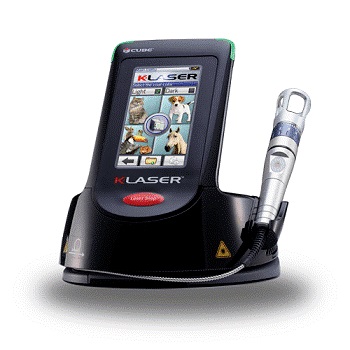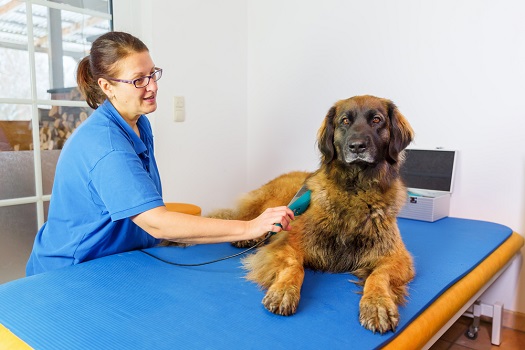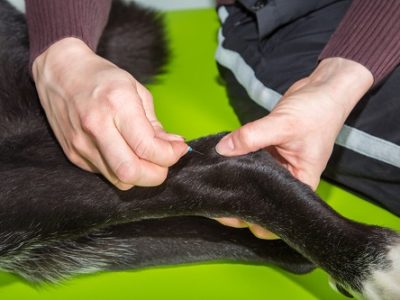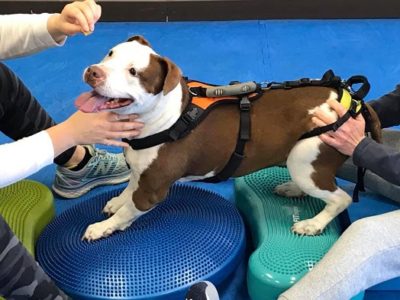
Table of Contents[Hide][Show]
Only one veterinary hospital in my city offered laser therapy for dogs when Sophie became paralyzed in 2010. We were referred there by a dear friend whose vet had just added the treatment to his practice. Laser therapy was only being used for dogs with severe arthritis at the time, but the vet agreed to treat Sophie’s paralyzed hind legs too.
Today therapeutic lasers are as common as X-ray machines and they’re used to heal canine patients with a variety of ailments.
If your dog’s been diagnosed with arthritis, disc disease or paralysis, you should know about laser therapy. Chances are good it will be part of your pet’s treatment plan.

Ask & Discover
Get personalized content recommendations and answers drawn from our website. Simply type your question or topic of interest, and our AI assistant will help you find relevant articles, tips, and insights. You can also have a natural conversation to explore topics in more depth.
My dog’s experience

Sophie went through six laser treatments before the vet decided it wasn’t improving her mobility. Unfortunately, we tried laser therapy when it was a new therapy. Since that time, the procedure has seen a lot of improvement. Today, veterinarians are able to dial in a diagnosis and the laser adjusts to the right dose of infrared light for a specific medical condition.
Still, even in 2010, laser therapy was a godsend for many dogs. I saw this firsthand with a dog who had his appointment right before Sophie. He was a big Labrador retriever with acute arthritis.
When the dog arrived for his first treatment, he had to be carried into the clinic on a stretcher because of the pain. At his next visit, the old Lab slowly walked into the vet’s office, with the help of a sling his owner had made from a towel.
By the third laser treatment, the Labrador retriever walked into the clinic entirely on his own. I can only imagine the final outcome after he went through the full course therapy.
Why laser therapy works
Laser Therapy or Cold Laser Therapy, as it’s officially called, has advanced significantly since my dog had procedure. Improved technology and the ease of using laser have made it a popular treatment for dogs, cats, horses, rabbits and other small animals.
Nearly 50 percent of veterinary hospitals in the U.S. have a laser therapy unit on hand.
Therapeutic lasers work by emitting a low-powered infrared laser light called ATP that’s cool to the touch and completely painless to the patient.
According to the American Animal Hospital Association, when the laser is applied to the surface of the skin, it starts a chemical reaction in the body. It releases endorphins, increases blood flow, reduces inflammation and accelerates the growth of cells and tissue.
In plain English, laser therapy for dogs decreases pain and inflammation while healing injured areas fast.
It’s an amazing treatment because it’s safe, non-invasive and considered to have no known side effects – except for one caveat.
The one risk of laser therapy for dogs

The procedure isn’t recommended for dogs with: cancer, thyroid problems, bleeding and autonomic “involuntary” nerve problems.
The reason is due to the laser’s ability to replicate cells quickly. That capability is great for healing, but not very good for cancer cells or bleeding. Veterinarians treating these conditions try to minimize cell growth.
Treatments are best used for these disorders:
- Arthritis
- Back problems and disc disease
- Joint injury
- Ligament or tendon injuries
- Fractures
- IVDD – Intervertebral Disc Disease
- Muscle sprains
- Hematomas
- Trauma
- Post-surgical wounds
- Chronic ear infections
- Hot spots
- Lick granulomas
- Bladder infections
What the laser unit looks like

K-Laser is one of the companies that manufactures laser therapy equipment for veterinary hospitals. I had the opportunity to talk with them at the Western Veterinary Conference. They explained how easy they’ve made the design of their laser. A veterinarian or vet tech is able to dial in a medical condition and the type of animal being treated and a preprogrammed treatment is automatically set.
Click to read about the benefits of Hyperbaric Oxygen Therapy for Dogs with Spine Problems

Get the Essential Guide
The Essential Guide of Products for Handicapped Dogs e-book is a labor of love for me. I wrote it to answer your most pressing questions about where to find the best products for your wheelchair dog. You’ll find products you didn’t know existed and each will improve your dog’s quality of life. Print a copy and keep it by your side.
How treatments are administered

- One of the most important components of laser therapy starts before the treatment begins. Everyone in the exam room must wear specially designed darkened goggles. The infrared light emitted by the laser can permanently damage the retina in your eyes, if you aren’t properly suited up. So, from the veterinarian and vet tech to your dog and you, everyone in the room wears these protective sunglasses.
- Next, your dog will be made comfortable for the procedure. Most vets provide a padded bed or blanket that’s laid floor or on an exam table. Our vet set a big comfy blanket on the ground for Sophie.
- Then the laser unit is set for your pet’s medical condition.
- The vet or tech slowly runs a handheld wand, attached to the laser, over the surface of your dog’s skin. The wand emits the laser light and is continuously moved back and forth across the injured area.
The number of sessions dogs need

Each session runs 15 to 30 minutes, but depending on your dog’s medical condition the frequency of treatments can vary quite a bit. Some vets require daily or near daily laser therapy sessions for acute conditions, while chronic problems are treated two or three times a week. Sophie and I went twice a week for a total of 6 treatments.
How dogs react to laser treatments
Most dogs find the treatment relaxing. Some even fall asleep. Dogs generally enjoy laser therapy because they have their owner by their side and the procedure is completely painless. I think they also tolerate it well because it makes them feel better, fast.
And on a final note, I want to mention expenses. Compared to other procedures, laser therapy for dogs is inexpensive. It ranges in price from $25-$45 per session and many veterinarians bundle packages of treatments to make it even more reasonably priced.
Exciting news for dogs with Degenerative Myelopathy
Degenerative Myelopathy is a heartbreaking progressive neurologic disease in dogs. The condition causes paralysis in the hind legs and then over time travels to the front limbs. The disease is terminal.
In 2020 results from a new study were published. It showed that when laser therapy was administered to two groups of dogs with the disease, progression of their symptoms slowed down.
You can read the complete article here: Laser Therapy Prolongs the Lives of Degenerative Myelopathy Dogs.






My best friend of 19yrs just passed away yesterday after a long battle with cancer. She fought hard but in the end the pain was just too much.
That said; I have a gently used large dog “Walkin Wheels” wheelchair up for purchase. If anyone is interested, please contact me or respond to my comment.
Tina, I’m sorry for your loss. If you’re unable to sell your girl’s cart please consider a donation to a special needs rescue in your area or a nonprofit like Gunnar’s Wheels.
Is there any vet’s that do this service in Waterloo or Cedar Falls,Ia
Hi John, Thanks for reaching out about your dog. You should have no problem finding a veterinarian in your area who provides Laser Therapy (AKA) Cold Laser Therapy. I quickly glanced the veterinarians in Cedar Falls and found that a clinic called Cedar Valley Veterinarians does Laser Therapy. Check with your regular vet about this clinic or give them a call. Cedar Falls is also home to one of the first rescue/rehab groups for dogs with mobility problems. I’m sure they would give you some direction about vet clinics in your area. The group is called Heath’s Haven. https://www.heathshavenrescue.com
-Sharon